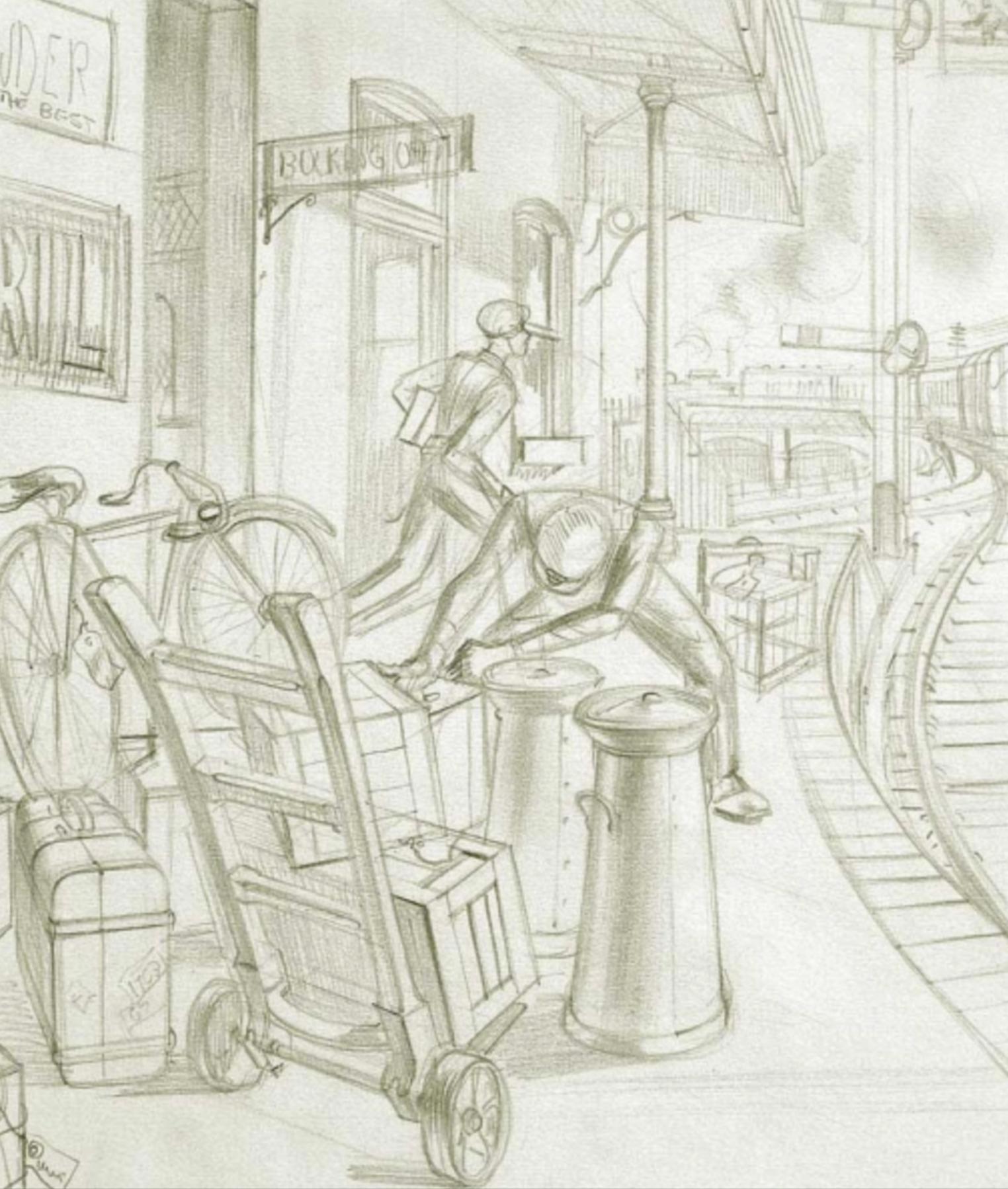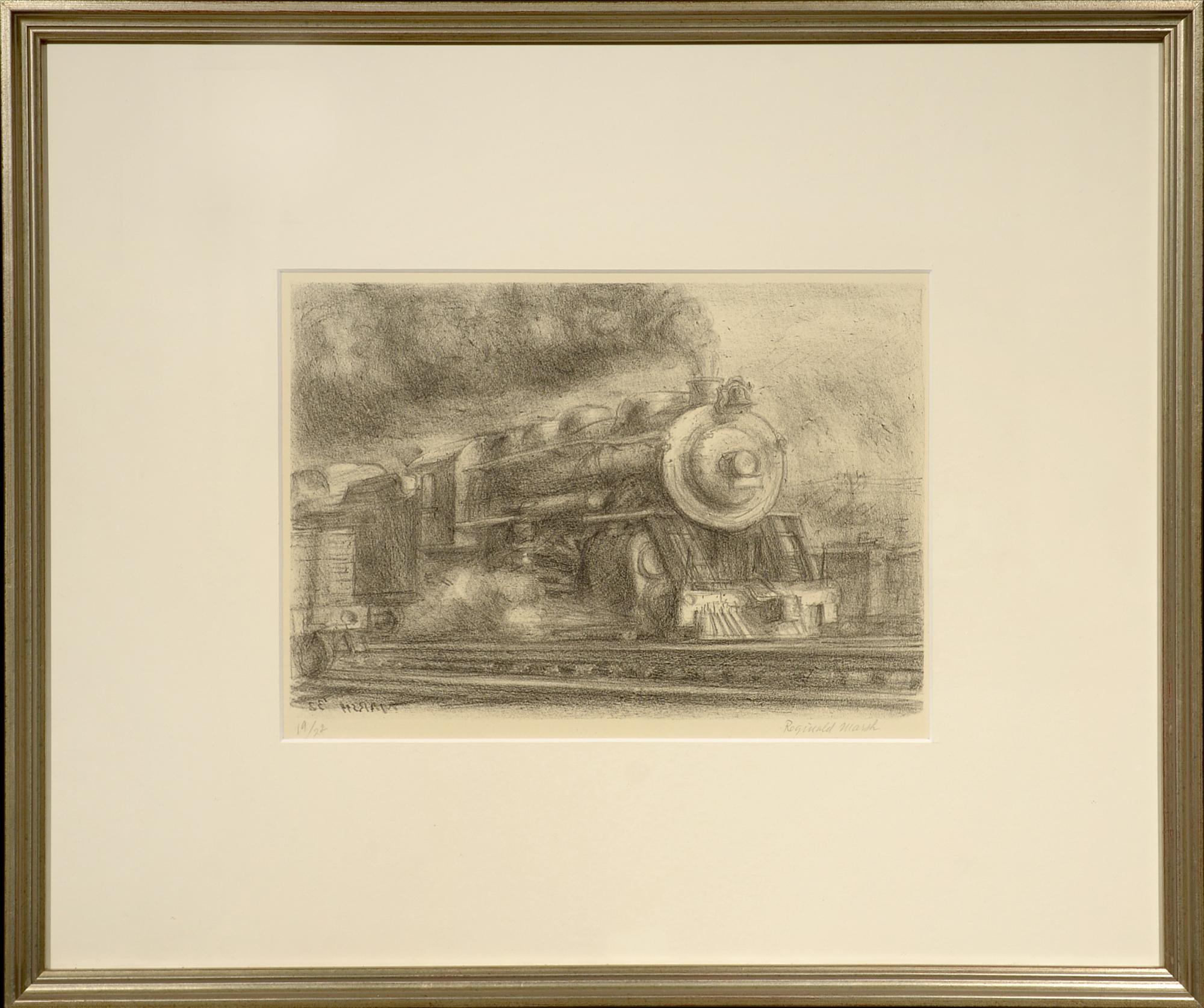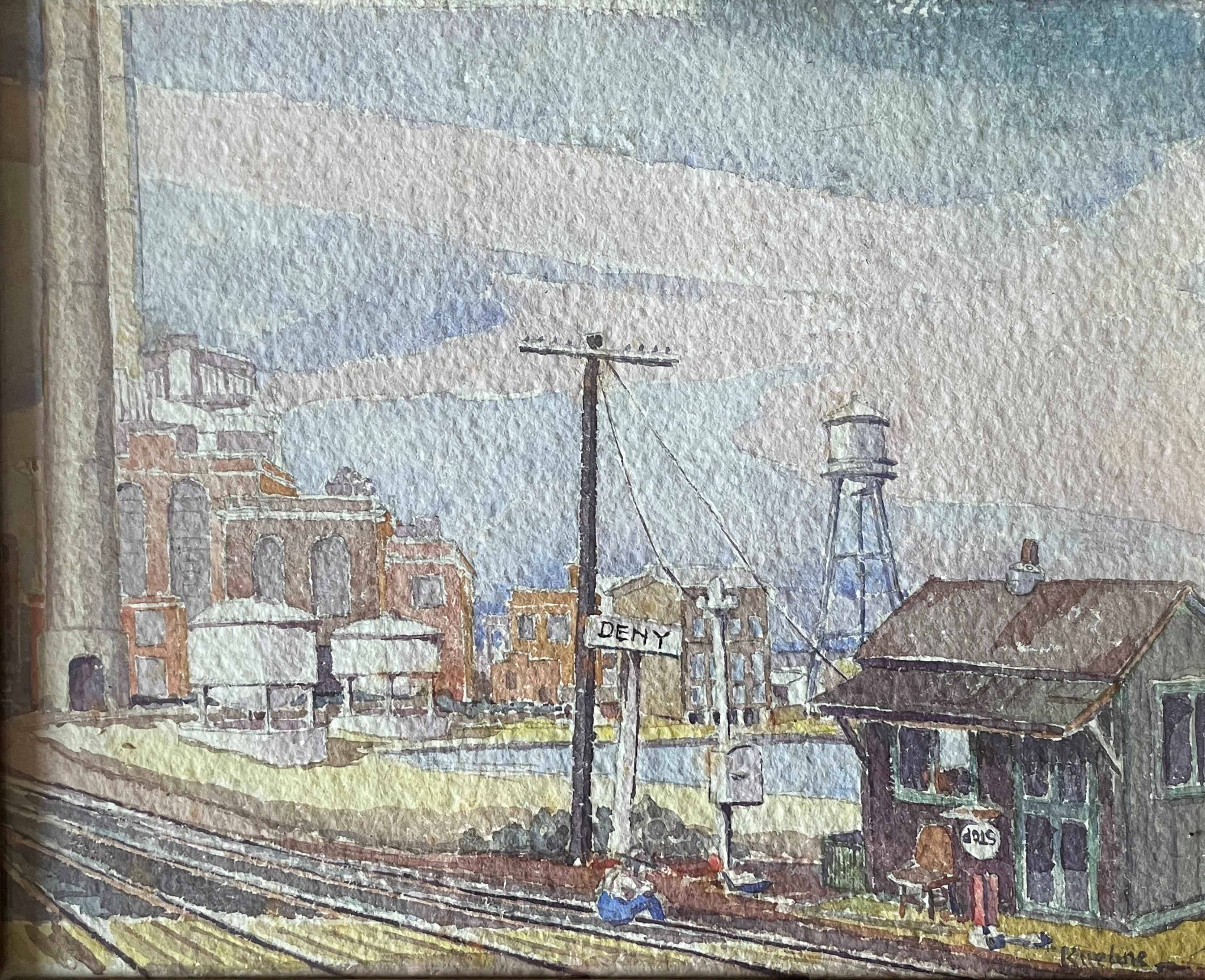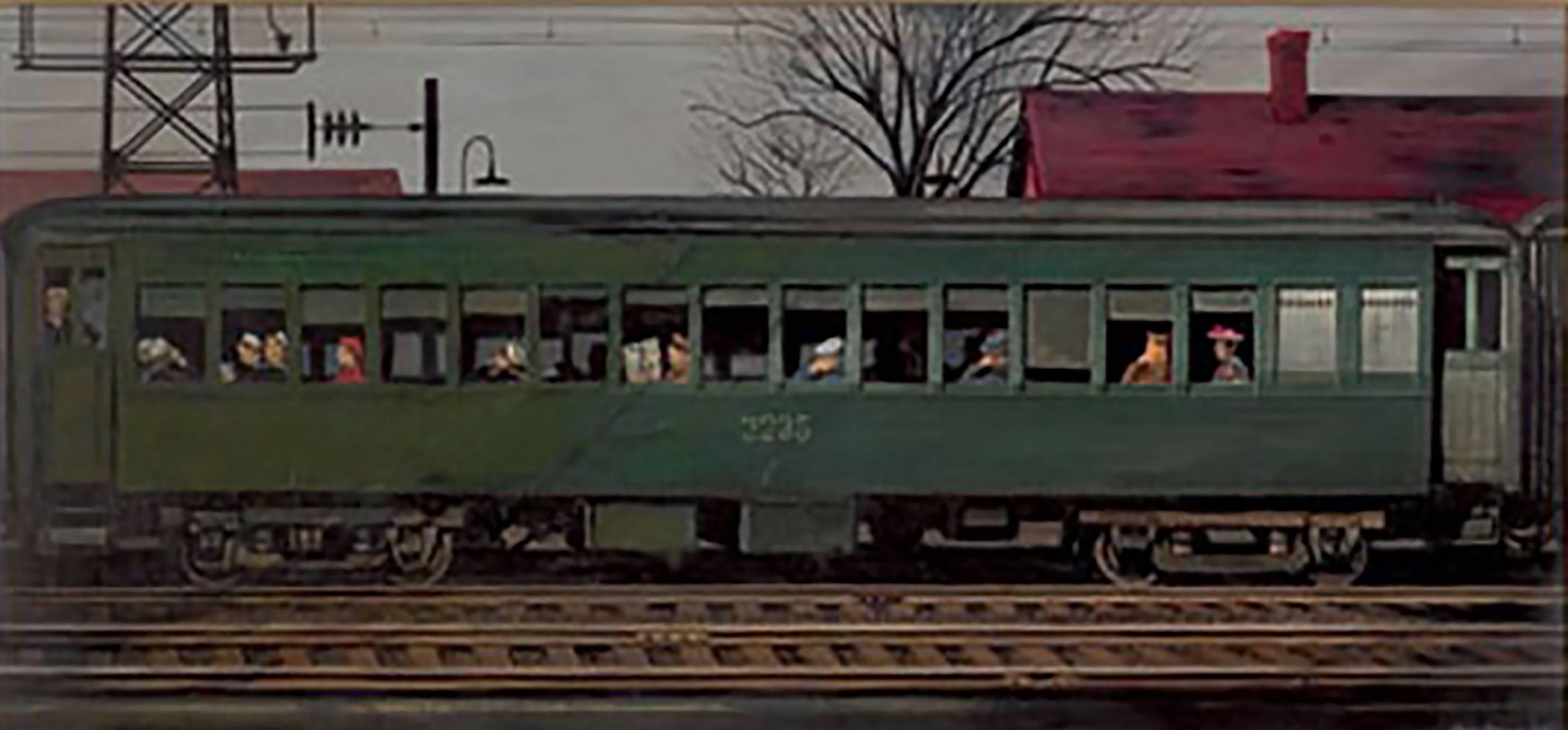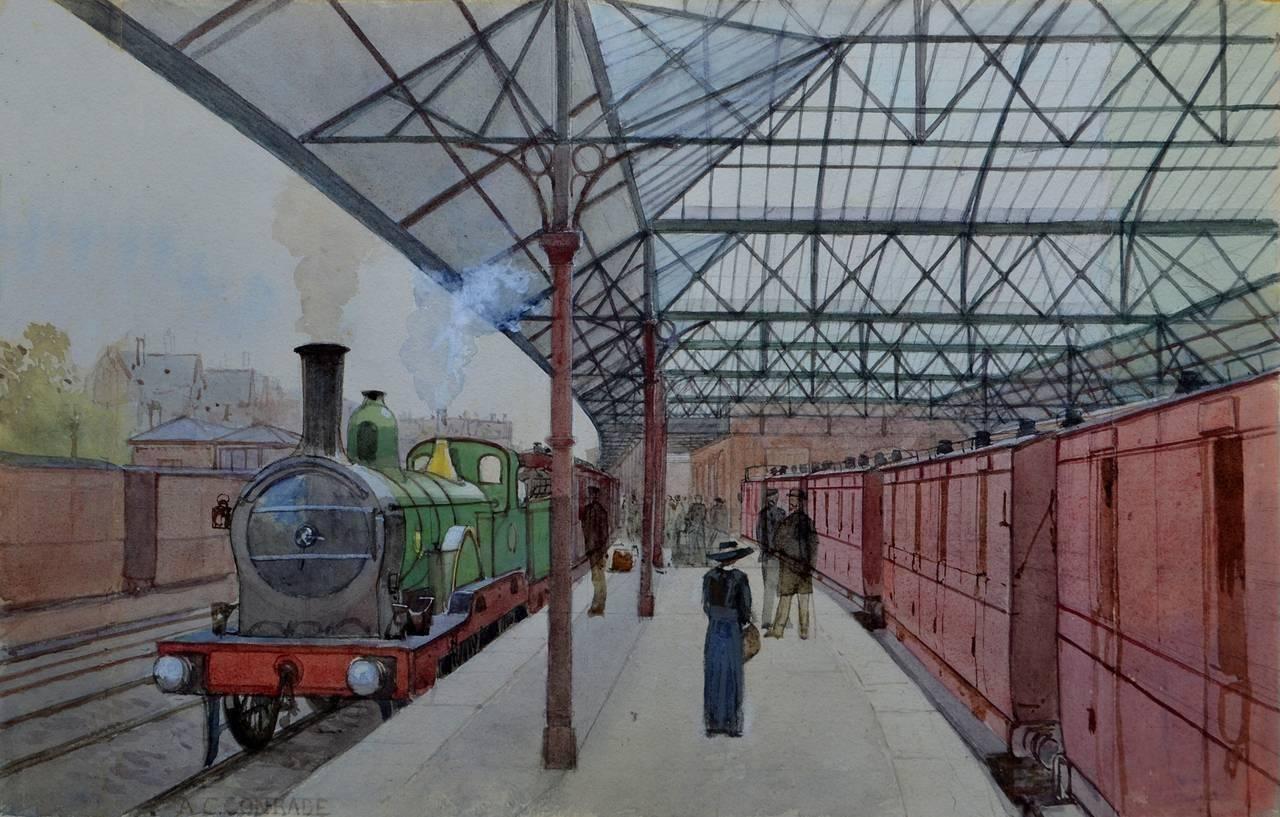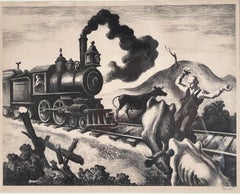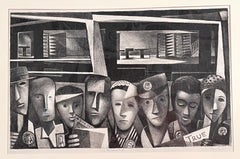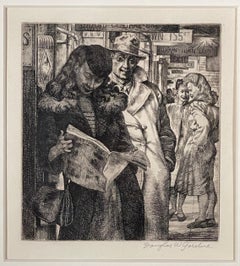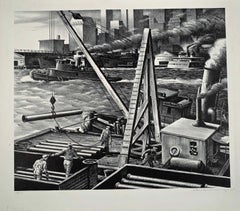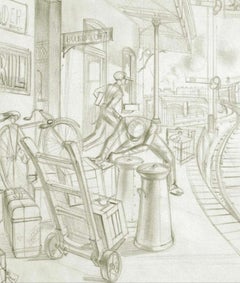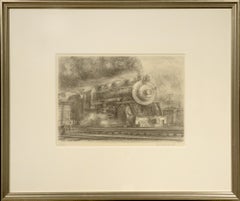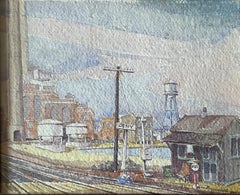Items Similar to UNTITLED (TRAIN STATION)
Want more images or videos?
Request additional images or videos from the seller
1 of 6
Robert TherrienUNTITLED (TRAIN STATION)
$350
£263.90
€304.11
CA$485.54
A$544.05
CHF 283.20
MX$6,655.62
NOK 3,594.68
SEK 3,395.14
DKK 2,270.24
Shipping
Retrieving quote...The 1stDibs Promise:
Authenticity Guarantee,
Money-Back Guarantee,
24-Hour Cancellation
About the Item
Therrien Jr., Robert (American 1847-2019). UNTITLED (TRADIN STATION) Ink on paper, not dated. 12 x 9 inches (sheet). Signed in Ink, lower right. Toning, and some adhesive residue, verso, else in very good condition.
- Creator:Robert Therrien (1947, American)
- Dimensions:Height: 16 in (40.64 cm)Width: 20 in (50.8 cm)
- Medium:
- Period:
- Condition:
- Gallery Location:Portland, ME
- Reference Number:1stDibs: LU367314358142
About the Seller
5.0
Recognized Seller
These prestigious sellers are industry leaders and represent the highest echelon for item quality and design.
Gold Seller
Premium sellers maintaining a 4.3+ rating and 24-hour response times
Established in 1966
1stDibs seller since 2016
350 sales on 1stDibs
Typical response time: 1 hour
Associations
International Fine Print Dealers Association
- ShippingRetrieving quote...Shipping from: Portland, ME
- Return Policy
Authenticity Guarantee
In the unlikely event there’s an issue with an item’s authenticity, contact us within 1 year for a full refund. DetailsMoney-Back Guarantee
If your item is not as described, is damaged in transit, or does not arrive, contact us within 7 days for a full refund. Details24-Hour Cancellation
You have a 24-hour grace period in which to reconsider your purchase, with no questions asked.Vetted Professional Sellers
Our world-class sellers must adhere to strict standards for service and quality, maintaining the integrity of our listings.Price-Match Guarantee
If you find that a seller listed the same item for a lower price elsewhere, we’ll match it.Trusted Global Delivery
Our best-in-class carrier network provides specialized shipping options worldwide, including custom delivery.More From This Seller
View AllSLOW TRAIN THROUGH ARKANSAS
By Thomas Hart Benton
Located in Portland, ME
Benton, Thomas Hart (American, 1889-1975 SLOW TRAIN THROUGH ARKANSAS. Fath . Lithograph, 1941. Edition of 250 published by Associated American Artists (A.A.A.). 9 7/8 x 12 inches (im...
Category
1940s Landscape Prints
Materials
Lithograph
SUBWAY SHIFT - THE SECOND FRONT
By Benton Murdoch Spruance
Located in Portland, ME
Spruance, Benton (American 1904-1967). SUBWAY SHIFT - THE SECOND FRONT. Fine and Looney 223. Lithograph, 1943. Fine and Looney cite two editions, one of 35 and one of 30, this being ...
Category
1940s Figurative Prints
Materials
Lithograph
EXPRESS STOP
By Douglas Gorsline
Located in Portland, ME
Gorsline, Douglas (American, 1913-1985). EXPRESS STOP. Etching, 1948. 6 3/8 x 5 3/4 inches (plate). Signed in pencil. Published by Associated American Artists In excellent condition....
Category
1940s Figurative Prints
Materials
Engraving
UNTITLED - SHIPPING YARD
By Edward A. Wilson
Located in Portland, ME
Wilson, Edward A. (American, born Scotland, 1886 - 1970). UNTITLED - SHIPPING YARD. Lithograph, 1945. Edition of 25, signed and numbered 23/25. 11 x 13 inches (image), 13 1/2 x 15 in...
Category
Mid-20th Century Landscape Prints
Materials
Lithograph
UNTITLED (DRAWING OF A BOAT #3; LIKELY IN ITALY)
By William Thon
Located in Portland, ME
Thon, William (American, 1906-2000).; UNTITLED (DRAWING OF A BOAT #3; LIKELY IN ITALY). Ink and wash on paper. Not dated. Unsigned. 14 x 17 inches. In excellent condition. From a ske...
Category
Mid-20th Century Landscape Drawings and Watercolors
Materials
Ink
INTERIORS VII: THE TRAIN FROM MUNICH
By Peter Milton
Located in Portland, ME
Milton, Peter (American, born 1930). INTERIORS VII: THE TRAIN FROM MUNICH. Milton 113. Resist-ground etching and engraving on copper, 1991. Edition of 175. Signed and dated in pencil. Printed on BFK Rives paper. 20 x 36...
Category
1990s Interior Prints
Materials
Engraving, Etching
You May Also Like
Approaching Train, Mid-20th Century Graphite Sketch, White Gold Frame
By Gordon Scott
Located in London, GB
Pencil on Paper
Image size: 10 x 8 ¾ inches
White Gold Frame
The Artist
Gordon Scott was trained at the Royal College of Art (1934-38) under Gilbert Spencer, Alan Sorrell and Charl...
Category
Mid-20th Century Modern Figurative Drawings and Watercolors
Materials
Paper, Graphite
Railroad, 1932, Reginald Marsh, Train, Lithograph, Metropolitan Museum of Art
By Reginald Marsh
Located in Wiscasset, ME
An urban realist painter, Marsh was born in Paris, France and began drawing as early as the age of three. His artistic studies were done at Yale University, the Art Student League in New York and in Paris. Marsh was a member of the National Academy, the Royal Society of Artists, London, the Southern Vermont Artists...
Category
1930s Realist Landscape Prints
Materials
Lithograph
"Train Station, " Max Kuehne, Industrial City Scene, American Impressionism
By Max Kuehne
Located in New York, NY
Max Kuehne (1880 - 1968)
Train Station, circa 1910
Watercolor on paper
8 1/4 x 10 1/4 inches
Signed lower right
Provenance:
Private Collection, Illinois
Max Kuehne was born in Halle, Germany on November 7, 1880. During his adolescence the family immigrated to America and settled in Flushing, New York. As a young man, Max was active in rowing events, bicycle racing, swimming and sailing. After experimenting with various occupations, Kuehne decided to study art, which led him to William Merritt Chase's famous school in New York; he was trained by Chase himself, then by Kenneth Hayes Miller. Chase was at the peak of his career, and his portraits were especially in demand. Kuehne would have profited from Chase's invaluable lessons in technique, as well as his inspirational personality. Miller, only four years older than Kuehne, was another of the many artists to benefit from Chase's teachings. Even though Miller still would have been under the spell of Chase upon Kuehne's arrival, he was already experimenting with an aestheticism that went beyond Chase's realism and virtuosity of the brush. Later Miller developed a style dependent upon volumetric figures that recall Italian Renaissance prototypes.
Kuehne moved from Miller to Robert Henri in 1909. Rockwell Kent, who also studied under Chase, Miller, and Henri, expressed what he felt were their respective contributions: "As Chase had taught us to use our eyes, and Henri to enlist our hearts, Miller called on us to use our heads." (Rockwell Kent, It's Me O Lord: The Autobiography of Rockwell Kent. New York: Dodd, Mead and Co., 1955, p. 83). Henri prompted Kuehne to search out the unvarnished realities of urban living; a notable portion of Henri's stylistic formula was incorporated into his work.
Having received such a thorough foundation in art, Kuehne spent a year in Europe's major art museums to study techniques of the old masters. His son Richard named Ernest Lawson as one of Max Kuehne's European traveling companions. In 1911 Kuehne moved to New York where he maintained a studio and painted everyday scenes around him, using the rather Manet-like, dark palette of Henri.
A trip to Gloucester during the following summer engendered a brighter palette. In the words of Gallatin (1924, p. 60), during that summer Kuehne "executed some of his most successful pictures, paintings full of sunlight . . . revealing the fact that he was becoming a colorist of considerable distinction." Kuehne was away in England the year of the Armory Show (1913), where he worked on powerful, painterly seascapes on the rocky shores of Cornwall. Possibly inspired by Henri - who had discovered Madrid in 1900 then took classes there in 1906, 1908 and 1912 - Kuehne visited Spain in 1914; in all, he would spend three years there, maintaining a studio in Granada. He developed his own impressionism and a greater simplicity while in Spain, under the influence of the brilliant Mediterranean light. George Bellows convinced Kuehne to spend the summer of 1919 in Rockport, Maine (near Camden). The influence of Bellows was more than casual; he would have intensified Kuehne's commitment to paint life "in the raw" around him.
After another brief trip to Spain in 1920, Kuehne went to the other Rockport (Cape Ann, Massachusetts) where he was accepted as a member of the vigorous art colony, spearheaded by Aldro T. Hibbard. Rockport's picturesque ambiance fulfilled the needs of an artist-sailor: as a writer in the Gloucester Daily Times explained, "Max Kuehne came to Rockport to paint, but he stayed to sail." The 1920s was a boom decade for Cape Ann, as it was for the rest of the nation. Kuehne's studio in Rockport was formerly occupied by Jonas Lie.
Kuehne spent the summer of 1923 in Paris, where in July, André Breton started a brawl as the curtain went up on a play by his rival Tristan Tzara; the event signified the demise of the Dada movement. Kuehne could not relate to this avant-garde art but was apparently influenced by more traditional painters — the Fauves, Nabis, and painters such as Bonnard. Gallatin perceived a looser handling and more brilliant color in the pictures Kuehne brought back to the States in the fall. In 1926, Kuehne won the First Honorable Mention at the Carnegie Institute, and he re-exhibited there, for example, in 1937 (Before the Wind). Besides painting, Kuehne did sculpture, decorative screens, and furniture work with carved and gilded molding. In addition, he designed and carved his own frames, and John Taylor Adams encouraged Kuehne to execute etchings. Through his talents in all these media he was able to survive the Depression, and during the 1940s and 1950s these activities almost eclipsed his easel painting. In later years, Kuehne's landscapes and still-lifes show the influence of Cézanne and Bonnard, and his style changed radically.
Max Kuehne died in 1968. He exhibited his work at the National Academy of Design, the Art Institute of Chicago, the Carnegie Institute in Pittsburgh, the Memorial Art Gallery of the University of Rochester, and in various New York City galleries. Kuehne's works are in the following public collections: the Detroit Institute of Arts (Marine Headland), the Whitney Museum (Diamond Hill...
Category
1910s American Impressionist Landscape Drawings and Watercolors
Materials
Paper, Watercolor
Tank Car Rail
By Reginald Marsh
Located in New York, NY
Reginald Marsh (1898-1954), Tank Car Rail, 1929, etching, signed lower right and numbered 15 lower left margin [also signed and dated in the plate]. Reference: Sasowsky 86, fifth sta...
Category
1920s American Realist Landscape Prints
Materials
Etching
A Passenger Train
By Stevan Dohanos
Located in Fort Washington, PA
Date: 1945
Medium: Oil on Board
Dimensions: 16.00" x 33.75"
Signature: Signed Lower Right
Exhibitions: Exhibited at International Galleries Contemporary American Illustration, May 1...
Category
1940s Landscape Paintings
Materials
Oil, Board
The Train Station Original Watercolour 20th Century
By Arthur Charles Conrade
Located in London, GB
ARTHUR CHARLES CONRADE
1863–1955
The Train Station
Watercolour & pencil, signed lower left
Image size: 12 x 14½ inches (30 x 37 cm)
Gilt frame
Category
20th Century Figurative Drawings and Watercolors
Materials
Watercolor, Pencil
More Ways To Browse
Train Painting
Vintage Train Art
Train Station Painting
Sally Bookman
Teruko Yokoi
Thomas Hartley Cromek
Virginia Ingram
Werner Drewes On Sale
Adolphe Ragon
Adriaan Lubbers On Sale
Anna Palm De Rosa
Barry Pittar
Carl Frederick Riter
Carl William Broemel
Charles Gordon Cutler
Clark Hobart On Sale
Dante Liberi
Ed Walaitis
